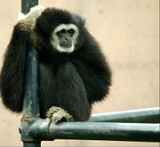
Gibbon
Overview
Gibbons are ape
s in the family
Hylobatidae (icon). The family is divided into four genera
based on their diploid chromosome
number: Hylobates
(44), Hoolock (38), Nomascus
(52), and Symphalangus (50). The extinct Bunopithecus sericus
is a gibbon or gibbon-like ape which, until recently, was thought to be closely related to the hoolock gibbons. Gibbons occur in tropical and subtropical rainforests from northeast India
to Indonesia
and north to southern China
, including the islands of Sumatra
, Borneo
and Java.
Also called the lesser apes, gibbons differ from great apes (chimpanzee
s, bonobo
s, gorilla
s, orangutan
s and human
s) in being smaller, exhibiting low sexual dimorphism
, in not making nests, and in certain anatomical details in which they superficially more closely resemble monkey
s than great apes do.
Ape
Apes are Old World anthropoid mammals, more specifically a clade of tailless catarrhine primates, belonging to the biological superfamily Hominoidea. The apes are native to Africa and South-east Asia, although in relatively recent times humans have spread all over the world...
s in the family
Family (biology)
In biological classification, family is* a taxonomic rank. Other well-known ranks are life, domain, kingdom, phylum, class, order, genus, and species, with family fitting between order and genus. As for the other well-known ranks, there is the option of an immediately lower rank, indicated by the...
Hylobatidae (icon). The family is divided into four genera
Genus
In biology, a genus is a low-level taxonomic rank used in the biological classification of living and fossil organisms, which is an example of definition by genus and differentia...
based on their diploid chromosome
Chromosome
A chromosome is an organized structure of DNA and protein found in cells. It is a single piece of coiled DNA containing many genes, regulatory elements and other nucleotide sequences. Chromosomes also contain DNA-bound proteins, which serve to package the DNA and control its functions.Chromosomes...
number: Hylobates
Hylobates
The genus Hylobates is one of the four genera of gibbons. It was once considered the only genus, but recently its subgenera have been elevated to the genus level. Hylobates remains the most speciose and widespread of gibbon genera, ranging from southern China to western and central Java...
(44), Hoolock (38), Nomascus
Nomascus
Nomascus is the second most speciose genus of gibbons . Originally this genus was a subgenus of Hylobates, and all individuals were considered one species, Hylobates concolor. Species within Nomascus are characterized by 52 chromosomes...
(52), and Symphalangus (50). The extinct Bunopithecus sericus
Bunopithecus sericus
Bunopithecus sericus is an extinct gibbon or gibbon-like primate. Its remains were first discovered in Sichuan, China, in strata from the Middle Pleistocene, but have since been found all over Southern Europe and Asia...
is a gibbon or gibbon-like ape which, until recently, was thought to be closely related to the hoolock gibbons. Gibbons occur in tropical and subtropical rainforests from northeast India
India
India , officially the Republic of India , is a country in South Asia. It is the seventh-largest country by geographical area, the second-most populous country with over 1.2 billion people, and the most populous democracy in the world...
to Indonesia
Indonesia
Indonesia , officially the Republic of Indonesia , is a country in Southeast Asia and Oceania. Indonesia is an archipelago comprising approximately 13,000 islands. It has 33 provinces with over 238 million people, and is the world's fourth most populous country. Indonesia is a republic, with an...
and north to southern China
China
Chinese civilization may refer to:* China for more general discussion of the country.* Chinese culture* Greater China, the transnational community of ethnic Chinese.* History of China* Sinosphere, the area historically affected by Chinese culture...
, including the islands of Sumatra
Sumatra
Sumatra is an island in western Indonesia, westernmost of the Sunda Islands. It is the largest island entirely in Indonesia , and the sixth largest island in the world at 473,481 km2 with a population of 50,365,538...
, Borneo
Borneo
Borneo is the third largest island in the world and is located north of Java Island, Indonesia, at the geographic centre of Maritime Southeast Asia....
and Java.
Also called the lesser apes, gibbons differ from great apes (chimpanzee
Chimpanzee
Chimpanzee, sometimes colloquially chimp, is the common name for the two extant species of ape in the genus Pan. The Congo River forms the boundary between the native habitat of the two species:...
s, bonobo
Bonobo
The bonobo , Pan paniscus, previously called the pygmy chimpanzee and less often, the dwarf or gracile chimpanzee, is a great ape and one of the two species making up the genus Pan. The other species in genus Pan is Pan troglodytes, or the common chimpanzee...
s, gorilla
Gorilla
Gorillas are the largest extant species of primates. They are ground-dwelling, predominantly herbivorous apes that inhabit the forests of central Africa. Gorillas are divided into two species and either four or five subspecies...
s, orangutan
Orangutan
Orangutans are the only exclusively Asian genus of extant great ape. The largest living arboreal animals, they have proportionally longer arms than the other, more terrestrial, great apes. They are among the most intelligent primates and use a variety of sophisticated tools, also making sleeping...
s and human
Human
Humans are the only living species in the Homo genus...
s) in being smaller, exhibiting low sexual dimorphism
Sexual dimorphism
Sexual dimorphism is a phenotypic difference between males and females of the same species. Examples of such differences include differences in morphology, ornamentation, and behavior.-Examples:-Ornamentation / coloration:...
, in not making nests, and in certain anatomical details in which they superficially more closely resemble monkey
Monkey
A monkey is a primate, either an Old World monkey or a New World monkey. There are about 260 known living species of monkey. Many are arboreal, although there are species that live primarily on the ground, such as baboons. Monkeys are generally considered to be intelligent. Unlike apes, monkeys...
s than great apes do.
Unanswered Questions

